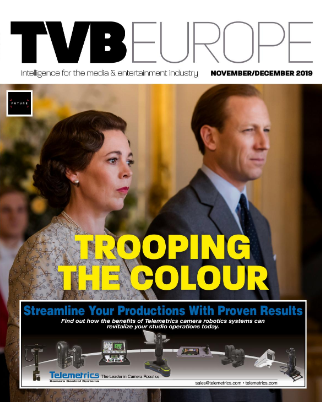Building an OTT field of dreams
Luke Durham, CTO at Switch Media shares his expertise around the challenge’s Sports Broadcasters face in their OTT delivery and provides recommendations on how they can drive a seamless, powerful user experience with high engagement and viewer satisfaction.
Over-the-top (OTT) viewing has really shaped the television landscape. More of us are turning to online services to feed our growing appetite for content, tailored to our viewing preferences. Our desire to watch what and when we want and binge several episodes at a time means that OTT services are competing with, and in some cases complementing, traditional linear channels.
Live sport is one of the few genres where broadcasters have been able to sustain their audience, but the tide is turning, and fast. The sports market, particularly for big spectator sports like football, F1, NFL, baseball, basketball and golf, is a billion–dollar industry. In 2018, the Dallas Cowboys were ranked the world’s most valuable sports team ($4.8bn) for the third consecutive year. Unsurprisingly, the next three most valuable sports franchises in the world were: Manchester United ($4.123bn); Real Madrid ($4.088bn); and Barcelona ($4.064bn). Television access to clubs like these command huge broadcast rights fees, which have traditionally been fought over by major global media companies with zero competition from outside. That is, until now.
The challenges for sports OTT broadcasters 
So what are the challenges when it comes to broadcasting live sports via OTT? Dealing with high numbers of viewers – the “stampeding herd” – for a short period of time is the key issue. Every OTT platform will experience bottlenecks, but the stampeding herd can significantly increase pressure. If you don’t plan for what happens and those bottlenecks cause the system to fail, it can bring down the entire platform. Things will fail, and this can result in some very unhappy viewers!
Another challenge is metadata, which is very different for OTT sports content. If a match is coming up at a certain time, creating an event schedule is a simple process, but when you get into fan engagement, it can be a challenge. You might want leader boards, team stats or bios etc. These stats are constantly being updated during and after each event and the metadata’s different across each sport. You can’t expect a single template system to cater for every scenario.
For most viewers, if they’re not watching an event live and haven’t isolated themselves from all forms of communication, then that moment is gone. This is where highlights are king but are traditionally labour intensive to produce. Modern machine learning and AI tools now provide the ability to automatically identify specific incidents as important and valuable. If a score changes or a player gets a red card, the system can detect that shift in play by identifying changes in on–screen graphics, audio commentary and crowd noises. Not only can this metadata be used for augmenting the content archives, it can automate the generation of clips and highlight reels that can then be automatically published onto social media.
Latency is also a key consideration. Latency is a measurement of delay between stimulation and response, or in terms of TV, between the event happening and when it’s presented on the viewer’s screen. Normally people don’t perceive latency; it’s too subtle for the human brain to detect. This is demonstrated when watching a thunderstorm. When it strikes near you, the lightning and sound seem to occur simultaneously, however when it occurs on the horizon, it’s possible to determine the distance by counting down the seconds between the lightning and its corresponding thunder. These light and sound signals have different latencies for the same event.
OTT services introduce many different ways to watch the same event, and when you compare them side–by–side they are rarely in sync and, compared to traditional broadcast, could be over 30 seconds different. This in itself isn’t a problem because typically you don’t watch two things at once. It becomes a spoiler when your neighbours are watching the same game and start cheering before you’ve seen the excitement. Or perhaps more frustratingly you’re watching on your phone and a notification comes in saying ‘GOOAAL!!’ overlaying the video, but you’re still many seconds behind the action.
With the increase in automation, these notifications can spread faster than the video can be delivered. This delivery delay can be related to the network, website performance and device/hardware, but not to encoding. The biggest challenge for content owners is to ensure that the OTT experience they’re providing matches as closely as possible to that of the linear TV broadcast experience.
The solution to this challenge varies considerably across different devices and requires adjustments to the entire video delivery system, from encoding to packaging, encryption, CDN and, most importantly, the player in the device itself.
 If you build it (properly) they will come
If you build it (properly) they will come
As well as considering the technical requirements to build a successful sports OTT platform, you need to think about eyeballs. The key is to create powerful fan engagement for each sport to suit the requirements and expectations of that specific fanbase. They may want detailed information, to see leader boards, commentary about what’s coming up next weekend; possibly view interviews with players, as well as historical games. This may be presented as a traditional linear channel between scheduled events, but also incurs significant costs. OTT technologies enable optimisation via manifest stitching, allowing live, on-demand and advertising content to be seamlessly combined in real-time and personalised to the individual viewer’s interests.
Building an OTT platform is a complicated beast. It’s recommended that media companies work with experienced OTT platform providers rather than attempt to create their platform in-house. To succeed you must architect the failure scenarios into the whole system; this can’t be an afterthought. From experience, a generic platform is unlikely to deal with stampeding herds.
With all these considerations, what does a benchmark platform look like for live sports streaming in 2020? It could just be a simple linear stream but if you’re serious, your OTT platform will include machine learning and AI, sophisticated metadata, personalised Server-Side Ad Insertion, low latency delivery, on-going fan engagement and rapid turnaround of highlights to publish on social media. These workflows will undoubtedly drive a seamless, powerful user experience with high engagement and viewer satisfaction.






